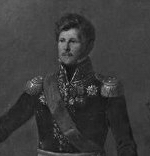General Julien Augustin Joseph Mermet

Born: May 9, 1772
Place of Birth: Le Quesnoy, Nord, France
Died: October 28, 1837
Place of Death: Paris, France
Arc de Triomphe: MERMET on the north pillar
Pronunciation:
The son of the master tailor of the regiment of Île-de-France, Julien Augustin Joseph Mermet was adopted as a child of the regiment in 1777. In 1791 and 1792 he served in the Antilles before returning to France where he was commissioned as a lieutenant in the 8th Hussars in November of 1792. The following February Mermet was promoted to capitaine. 1793 continued to be a busy year for him, because in September he was wounded by a saber blow to the head at the affair of Killem and then he went on to be wounded by a ball to the side at the affair of Schwastybourg. That November Mermet was promoted to chef d'escadron in the 7th Hussars and he was wounded by a saber blow to the right shoulder at Kaiserslautern at the end of the month. He next received a promotion to chef de brigade in January of 1794 and then in September he joined General Hoche's staff. In 1795 Mermet served at the combat of Auray. On January 1st of 1796 he was promoted to général de brigade and that May he served at the combat of Locminé. Mermet next served under Hoche on the failed expedition to Ireland and afterwards he joined the Army of the Sambre and Meuse as part of Bernadotte's division. Following Bernadotte's division, he went to the Army of Italy in March of 1797 and he served at the Tagliamento. In 1797 Mermet took charge of the 10th Hussars and in 1798 he was designated for the Army of England. In 1799 he took command of a brigade of cavalry of the reserve of the Army of Italy and in November he served at Genola. The next year he served in Delmas' division and he was wounded by a shot in the crossing of the Mincio at Monzembano in December.
During the years of peace that followed, Mermet was employed in a variety of military divisions. In February of 1805 he was promoted to général de division and when war broke out later that year he was sent to Italy to command a division of dragoons under Marshal Masséna. In February of 1806 Mermet took command of the reserve of dragoons of the Army of Naples and in October he took command of the military division made up of Terra di Lavoro, Montefusco, and Salerno.
In September of 1808 Mermet was sent to Spain to take command of an infantry division. He served as part of II Corps at the Battle of Corunna in January of 1809 where he was wounded. He went on to win at Braga against the Portuguese in March and then in April of 1810 he commanded the 2nd Division of Marshal Ney's VI Corps in the Army of Portugal. Mermet served at the Siege of Almeida in the summer of 1810. In March of 1811 he was wounded at the combat of Foz d'Arunce and then he was placed as part of Loison's VI Corps. That May Mermet served at the Battle of Fuentes de Oñoro and afterwards he returned to France. Back in France he took command of the 27th military division and he was named a Baron of the Empire, a Knight of the Iron Crown, and a Grand Dignitary of the Order of Two Sicilies. In 1812 Mermet returned to the Army of Portugal to command a division of dragoons and then in December he took command of all the cavalry of the Army of Portugal. In June of 1813 he served at the Battle of Vitoria and afterwards he was sent to Italy.
Once in Italy Mermet took command of the cavalry corps under Prince Eugene. He served at Caldiero in November and then made a sortie before Legnano later that month. In February of 1814 he served at the Battle of the Mincio. After Napoleon's abdication and the Bourbon Restoration, Mermet was named a Grand Officer of the Legion of Honor and inspector general of cavalry in multiple military divisions. When in 1815 Napoleon escaped from exile and marched to Paris, Mermet refused to follow Marshal Ney in rallying to Napoleon. For this he was temporarily exiled but in June he was employed as inspector general of cavalry in the Corps of Observation of the Eastern Pyrenees. After the Second Restoration, he continued his career as a cavalry officer.
Bibliography
- Divry, Arnauld. Les Noms Gravés sur l'Arc de Triomphe. Paris: L'Harmattan, 2017.
- Six, Georges. Dictionnaire Biographique des Généraux & Amiraux Français de la Révolution et de l'Empire (1792-1814). 2 vols. Paris: Gaston Saffroy, 2003.
Related Pages:
Updated June 2018
© Nathan D. Jensen